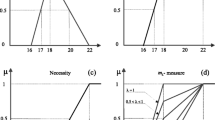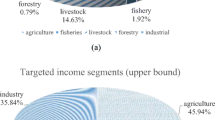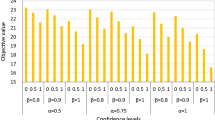Abstract
A copula-measure Me based interval multi-objective multi-stage stochastic chance-constrained programming (CMIMOMSP) model is proposed for water consumption optimization. It can conduct water allocation amid multiple users and multiple stages, and deal with the uncertainties presented as interval numbers, random fuzzy interval numbers, and stochastic variables. It improves upon multi-stage stochastic chance-constrained programming by introducing the multi-objective programming, and it can tradeoff the relationships amid economic benefit, full usage of water resources, and economic loss. It enhances the accuracy of copula function and conditional distribution function through proposing the interval functions. Besides, it can deal with the impact of the decision attitudes of managers on water allocation by formulating the function equation between water demand and the optimistic-pessimistic factor. The CMIMOMSP model is applied to a case study of the Heihe River Basin to verify its application. The results indicate that: (1) the optimistic-pessimistic factors have different degrees of positive influences on water allocation for industrial, domestic and ecological sectors; (2) the joint violated probability and optimistic-pessimistic factor have various range of impacts on agricultural water allocation; (3) tthe objective function values have different variation tendencies with the rise of joint violated probabilities and optimistic-pessimistic factors. Its robustness is enhanced by comparing it with the three single-objective programming models. The CMIMOMSP model can provide various water allocation schemes for managers with different risk attitudes in semi-arid and arid districts.










Similar content being viewed by others
References
Chen F, Huang GH, Fan YR, Chen JP (2017) A copula-based fuzzy chance-constrained programming model and its application to electric power generation systems planning. Appl Energy 187:291–309
Fan YR, Huang WW, Huang GH, Li YP, Huang K, Li Z (2016) Hydrologic risk analysis in the Yangtze River basin through coupling Gaussian mixtures into copulas. Adv Water Resour 88:170–185
Feng XS, Sun DY, Hu WD, Guo JP (2017) Application of the copula function in frequency analysis of drought in Weihe river basin. J Irrig Drain E 36(12):110–117
Fu Q, Li L, Li M et al (2018) An interval parameter conditional value-at-risk two-stage stochastic programming model for sustainable regional water allocation under different representative concentration pathways scenarios. J Hydrol 564:115–124
Gu JJ, Guo P, Huang GH, Shen N (2013) Optimization of the industrial structure facing sustainable development in resource-based city subjected to water resources under uncertainty. Stoch Environ Res Risk A 27:659–673
Guo P, Huang GH, Li YP (2010) Inexact fuzzy-stochastic programming for water resources management under multiple uncertainties. Environ Model Assess 15:111–124
Kong XM, Huang GH, ASCE AM, Li YP, Fan YR, Zeng XT, Zhu H (2018) Inexact copula-cased stochastic programming method for water resources management under multiple uncertainties. J Water Resour Plan Manag. https://doi.org/10.1061/(ASCE)WR.1943-5452.0000987
Li CQ (2016) Research on project evaluation of warship power system based on interval-based analytic hierarchy process. Ship Sci Technol 38:124–127 ({\bf in Chinese})
Li M, Guo P (2015) A coupled random fuzzy two-stage programming model for crop area optimization—a case study of the middle Heihe River basin, China. Agric Water Manag 155:53–66
Li YP, Huang GH (2008) Interval-parameter two-stage stochastic nonlinear programming for water resources management under uncertainty. Water Resour Manag 22:681–698
Li YP, Huang GH, Nie SL (2006) An interval-parameter multi-stage stochastic programming model for water resources management under uncertainty. Adv Water Resour 29:776–789
Li YP, Huang GH, Chen X (2009) Multistage scenario-based interval-stochastic programming for planning water resources allocation. Stoch Environ Res Risk A 23:781–792
Li M, Guo P, Yang GQ, Fang SQ (2014) IB-ICCMSP: an integrated irrigation water optimal allocation and planning model based on inventory theory under uncertainty. Water Resour Manag 28:241–260
Li M, Guo P, Ren CF (2015) Water resources management models based on two-level linear fractional programming method under uncertainty. J Water Resour Plan Manag. https://doi.org/10.1061/(ASCE)WR.1943-5452.0000518
Li Z, Mobin M, Keyser T (2016) Multi-objective and multi-stage reliability growth planning in early product-development stage. IEEE Trans Reliab 65:769–781
Liu XM, Huang GH, Wang S, Fan YR (2016) Water resources management under uncertainty: factorial multi-stage stochastic program with chance constraints. Stoch Environ Res Risk A 30:945–957
Safaei M (2014) An integrated multi-objective model for allocating the limited sources in a multiple multi-stage lean supply chain. Econ Model 37:224–237
Salvadori G, De M, Kottegoda CN, Rosso R (2007) Extremes in nature: an approach using copula
Shibu A, Reddy MJ (2014) Optimal design of water distribution networks considering fuzzy randomness of demands using cross entropy optimization. Water Resour Manag 28:4075–4094
Suo C, Li YP, Wang CX, Yu L (2017) A type-2 fuzzy chance-constrained programming Method for planning Shanghai’s energy system. Int J Electr Power 90:37–53
Thevaraja M, Rahman m (2019) Regression analysis based on copula theory by using Gaussian family copula. Int J Stat Reliab Eng 6(1):24–28
Tu Y, Zhou X, Gang J, Liechty M, Xu J, Lev B (2015) Administrative and market-based allocation Mechanism for regional water resources planning. Resour Conserv Recycl 95:156–173
Wang ZH, Wang ZL, Yu S, Zhang KW (2019) Time-dependent mechanism reliability analysis based on envelope function and vine-copula function. Mech Mach Theory 134:667–684
Wang YZ, Li Z, Guo SS, Zhang F, Guo P (2020) A risk-based fuzzy boundary interval two-stage stochastic water resources management programming approach under uncertainty. J Hydrol. https://doi.org/10.1016/j.jhydrol.2020.124553
Xu J, Yao L (2011) Random-like multiple objective decision making
Xu J, Zhou X (2013) Approximation based fuzzy multi-objective models with expected objectives and chance constraints: application to earth-rock work allocation. Inf Sci 238:75–95
Xu Y, Huang G, Qin X (2009) Inexact two-stage stochastic robust optimization model for water resources management under uncertainty. Environ Enf Sci 26:1765–1776
Yang F, Zhang HW, Liu HB (2002) Research on forecasting approach of short term municipal water consumption. J Tianjin Univ 35:167–170
Yu L, Li YP, Huang GH, Fan YR, Nie S (2018) A copula-based flexible-stochastic programming Method for planning regional energy system under multiple uncertainties: a case study of the urban agglomeration of Beijing and Tianjin. Appl Energy 210:60–74
Zeng XT, Li YP, Huang W, Chen X, Bao AM (2014) Two-stage credibility-constrained programming with Hurwicz criterion (TCP-CH) for planning water resources management. Eng Appl Artif Intell 35:164–175
Zhang C, Li M, Guo P (2017) An interval multistage joint-probabilistic chance-constrained programming model with left-hand-side randomness for crop area planning under uncertainty. J Clean Prod 167:1276–1289
Zhang F, Zhang CL, Yan Z, Guo H, Wang SS, Y.Y., and Guo P (2018) An interval nonlinear multi-objective programming model with fuzzy-interval credibility constraint for crop monthly water allocation. Agric Water Manag 209:123–133
Zhang F, Guo P, Engel BA, Guo S, Zhang C, Tang Y (2019) Planning seasonal irrigation water allocation based on an interval multi-objective multi-stage stochastic programming approach. Agric Water Manag 223:105692
Zhou Y, Huang GH, Yang B (2013) Water resources management under multi-parameter interactions: a factorial multi-stage stochastic programming approach. Omega 41:559–573
Acknowledgements
This research was supported by the National Natural Science Foundation of China (41871199). We gratefully acknowledge funding from the China Scholarship Council (CSC201906350189).
Author information
Authors and Affiliations
Corresponding author
Additional information
Publisher's Note
Springer Nature remains neutral with regard to jurisdictional claims in published maps and institutional affiliations.
Appendix
Appendix
The measure Me can be defined as follows:
where \(Pos\left\{ {\xi \leq r} \right\}{\text{=}}\mathop {\sup }\nolimits_{{u \leq r}} \mu (u)\) and \(Nec\left\{ {\xi \leq r} \right\}{\text{=1-}}\mathop {\sup }\nolimits_{{u>r}} \mu (u)\); Pos is the possibility measure; Nec is the necessary measure; λ is the optimistic-pessimistic parameter to determine the combined attitude of a manager.
The probability distribution of triangular fuzzy numbers \(\widetilde {\xi }=({\xi _1},{\xi _2},{\xi _3})\) based on the measure Me is show as follows:
where \({\xi _1},{\xi _2},{\xi _3}\) are the minimum possible value, possible value and maximum possible value, respectively.
The expected value of \(\widetilde {\xi }\) based on the measure Me.
Finally, the expected value of \(\widetilde {\xi }\) is expressed as \({E^{Me}}[\xi ]=\frac{1}{2}({\xi _2}+{\xi _1})+\frac{\lambda }{2}({\xi _3} - {\xi _1})\)
Rights and permissions
About this article
Cite this article
Wang, Y., Guo, P. The interval copula-measure Me based multi-objective multi-stage stochastic chance-constrained programming for seasonal water resources allocation under uncertainty. Stoch Environ Res Risk Assess 35, 1463–1480 (2021). https://doi.org/10.1007/s00477-020-01913-x
Received:
Revised:
Accepted:
Published:
Issue Date:
DOI: https://doi.org/10.1007/s00477-020-01913-x




